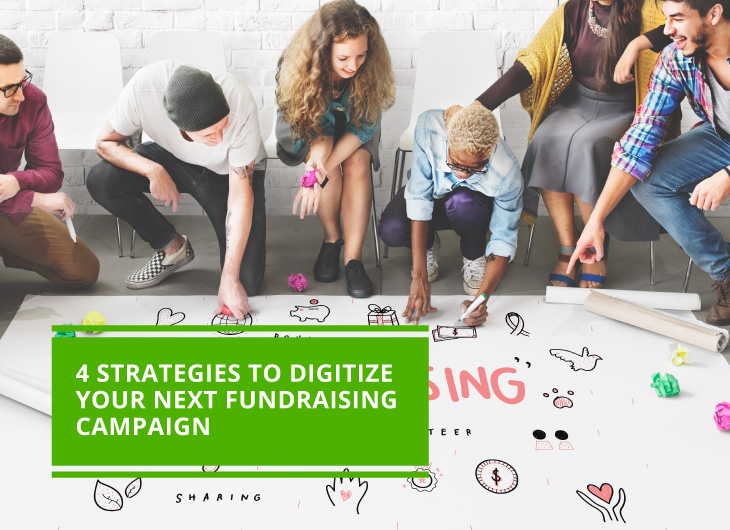Software and digital tools have redefined how nonprofits think about outreach and organization. While paper physical copies still have their place as reference documents, digitizing your fundraising campaigns allows your nonprofit’s team easy access to shared tools while communicating with supporters across the country.
Moving online is a significant investment of time and money. Before purchasing software, review your nonprofit’s current practices to figure out what needs to go online and why.
Everything your nonprofit does should help further an internal goal. For your next fundraising campaign, target a few specific areas to digitize. And be sure not to overwhelm your staff with new software to learn in the middle of a fundraiser!
Our team at Grassroots Unwired has experience helping nonprofits digitize their clipboards, file cabinets, and registration forms. To help your nonprofit choose a digitization goal that makes sense for you, here are four strategies we recommend for your online fundraising campaigns:

- Optimize Online Engagement Tactics
- Make the Most of Your Software
- Manage Events Virtually
- Invest in Your Grassroots Field Technology
These strategies aim to make use of what your nonprofit already has to leverage your donor data, outreach efforts, and software to maximum potential. New strategies and software can be frustrating at first, but remember that digitizing should make fundraising processes easier on your nonprofit through automation and data collection.
1. Optimize Online Engagement Tactics
Nonprofits have slowly realized the potential of social media, and many have Facebook, Twitter, or Instagram accounts to connect with supporters. Others who are still social media shy likely still use online practices such as email. Whether your nonprofit is a social media star or still figuring out an email service provider, your first step towards digitizing your fundraising campaigns is reviewing and refining your current online outreach approach.
Before you can begin optimizing your social media plan, take the following steps to analyze your current practices:
- Identify your audience. Analyzing your audience requires understanding who your nonprofit wants its message to reach, who the messages are actually reaching, and how to align those two groups. Check the demographics of your current social media following, email subscription list, and donor data. Use the information you find to create audience personas and determine how you would reach out to them. A persona is a profile of a hypothetical donor, volunteer, or other supporter. Your personas should have ages, professions, and incomes similar to your audience, as well as a name and goal. Creating personas allows your nonprofit to identify specific wants your audience is likely to have, so you can refine your outreach efforts to appeal to them.
- Match your strategies to your audience. Once you’ve identified your audience, examine your current social media practices to see if they make sense for your audience. For example, if you are engaging supporters at events or while going door-to-door, you might consider encouraging them to post selfies and participate in hashtags. Oftentimes, this type of “viral” message of support for your cause can be as valuable as a small dollar donation.
- Adapt your content to each platform. Every social media plan has its advantages and best practices for success. You can post the same content across different platforms as long as you edit it to meet the new platform’s expectations. If your Facebook post has one eye-catching header image, consider creating additional graphics when you get the message out on Instagram.
- Create sustainable posting targets. Whether your nonprofit has a well-rounded marketing team or you’re a team of one, your nonprofit should still make a social media calendar to maintain regular outreach activity. Managing multiple accounts can be a juggling act, and it might be necessary to reduce posting on accounts with less engagement to propel your momentum on platforms where you find success.
Nonprofits are most successful at attracting and converting donors when they reach out to them on multiple platforms. Maintaining multiple social media accounts lets your nonprofit interact with single-platform users as well as build brand recognition with supporters across platforms.
In addition to social media, your nonprofit can optimize its emailing practices to further build relationships with supporters. Email fundraising has two primary strategies for increasing engagement metrics: increase personalization and increase the number of emails sent. These can seem contradictory, but both can be achieved with the right email service provider and client relationship management software:
- Email Service Providers. Email service providers can help you manage your email list and quickly send emails in bulk. Sending hundreds of emails from your regular email client (Gmail, Yahoo!, etc.) can result in your emails being marked as spam, which means your supporters will likely never see them. Email service providers have authentication from internet service providers who decide whether emails are spam.
- Client Relationship Management Software. Client relationship management software (or CRMs) helps you collect your supporters demographic and contact information, track engagement and donation history, and automate outreach. Use your CRM to populate email templates with donor information to create unique emails, demonstrating your nonprofit’s knowledge and investment in its supporters.
Once your email and social media practices have been updated, consider branching into other strategies to expand your potential supporter touchpoints. Phone, texting or brand new video canvassing technology can supplement broader fundraising efforts on social media by individualizing communication with one-on-one interactions with key supporters.
2. Make the Most of Your Software
As your nonprofit browses fundraising software or looks to better leverage current software, keep track of each solution's specialty. As mentioned in the previous tip, your nonprofit should invest in a CRM, and most CRM and virtual fundraising software providers have designed their software to fill a specific niche in the nonprofit sector.
Double the Donation’s guide to virtual fundraising software reviews some of the most popular options and how they can provide the most benefit to your campaign. A few key features to look for are:
- Matching donations. Matching and volunteer grants are additional donations your supporters’ employers make to your nonprofit when their employees donate or volunteer. Integrate matching donations into your donation form to help supporters identify their eligibility and apply for a matching grant.
- Virtual event support. Virtual events have risen in popularity this past year due to the necessities of social distancing, and they are likely here to stay as a staple of online fundraising. Check virtual fundraising software for features such as livestreaming support, text-to-give tools, and peer-to-peer add-ons.
- Donor management tools. Your software should allow you to track, communicate, and engage with donors during their entire engagement. Donor management tools allow your nonprofit to cultivate more personalized relationships with donors while also enabling your nonprofit to track trends in your donors’ giving patterns.
Finding the right software takes time, and it’s better to do your research than purchase a product that doesn’t meet your nonprofit’s needs. Ask questions and request demos as you shop around to figure out the pros and cons of each of your options.
3. Manage Events Virtually
Even if your nonprofit prefers in-person events, chances are you have at least considered hosting a virtual event this past year. Whether on or offline, event management software and tools have become a necessity for registration processing, CRM integration, and efficient check-in procedures for the day of the event.
Virtual events require work and specialization to translate the activities you would do face-to-face onto a computer screen. Some events lend themselves to virtual communication more than others. For example, your nonprofit can still hold presentations and Q&A sessions, but might struggle with marathons or galas. If you have trouble thinking of ideas, consider researching online or looking up guides like this one for inspiration.
Like their physical counterparts, virtual fundraising events require planning. Establish a goal for the event and create a checklist so nothing gets left undone. A few online-specific tasks to keep in mind are:
- Create event pages. Your event will need at least two web pages in addition to the event itself: the information page and the landing page. The information page explains the details of your event for you to share when you promote the event. The landing page should be a page only attendees can access that will take them to the event page.
- Create virtual signup forms. Your volunteers and attendees both still need to register for your event. Create or look into virtual registration software to build forms with your specific information fields.
- Test software. Don’t let tech errors interrupt your event! Test all videos, activities, and live streams before the event to make sure everything works and looks good from your viewers’ end.
Virtual fundraising events don’t just increase your revenue, they also engage supporters during a time where your nonprofit might not be at front of mind due to physical distance. Collect donations, but also focus on creating a fun, technical difficulty-free night by understanding your supports and hosting an event that will resonate with them.
4. Invest in Your Grassroots Field Technology
Nonprofit software comes in all shapes and sizes, and with research, your nonprofit can likely find software that matches your field. Animal rescues, dance studios, and community advocacy groups all have technology specific to their business practices.
The right technology can help traditionally offline fields find their place in the digital landscape.
For example, political canvassing and advocacy groups are known for flocking to the streets with clipboards. However, organizers might decide that reading contact information and compiling hundreds of signatures is too tedious to be done manually. In this example, software like Grassroots Unwired’s virtual canvassing software, which provides real-time reporting and robust script branching for volunteers, could minimize data entry times and let the group focus on expanding their efforts.
Physical separation has been a challenge for many organizations that relied on in-person gatherings, and the creators of field-specific technology create software solutions designed to meet those exact challenges. Browse industry forums and check what products similar organizations are using to find technology built with your nonprofit in mind.
Moving online requires research, money, and time. However, improving your current online practices with new and existing software will let your nonprofit identify and tailor fundraising strategies to your donors.
Start by taking inventory and making the improvements you can with your current setup, then kickoff the browsing process with research, questions, and whatever else your nonprofit needs to find the software that will raise your fundraising campaign to the next level online.



COMMENTS